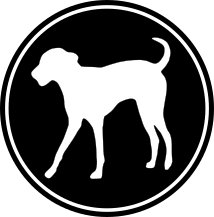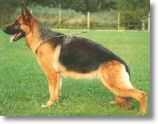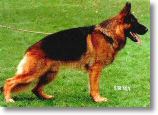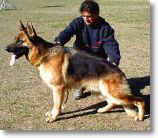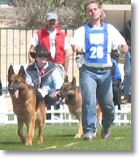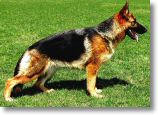For a number of reasons, this year’s United Schutzhund Clubs of America (USA) Sieger Show was smaller than usual, though there were sufficient world-class dogs there, that anybody would be proud to own. The relative isolation of a West-coast location kept many from east of the Rockies from attending, although last year’s show in Las Vegas did not suffer to the same degree. Air travel is down partly because of the post-9-11 syndrome, partly from fears connected with Operation Iraqi Freedom and supposed danger of extremist-Islamic retaliation, and partly the general economy which is marked by inflation and uncertainty regarding layoffs by employers. Add to that the reported dissatisfaction with the choice of judges (something that one hears at almost any event): this year complaints centered on this WUSV-affiliated club only having one SV judge (Arno Humberdros) out of the five officiating, while the WDA club usually uses only SV judges. This is only partly true, as my friend Virgilio Garbin from Chile, while listed in the catalog as from COAPA, is a retired SV judge. The SV has this stupid rule (as does USA) about mandatory de-listing when a person reaches 70, regardless of health or ability. But even then, some voiced concern that only one or two out of five was too far from a majority for what should be the most prestigious GSD specialty show in North America.
There was a disappointingly tiny entry (12, after deducting the 3 who failed the courage test) in the Open (SchH-titled) Bitch class. This was judged by Johannes Grewe, whose club put on an over-all very well managed show at a good venue in Bakersfield California, only a few hours drive from any major airport. He had probably the best quality of any class to choose from, and awarded half of them VA. Most felt that was far too may, given the number attending, in light of the fact that in Germany there may be around 10 VA in an entry of well over 100. It makes more sense to call 9% “Select” (Auslese) than 50%. In my view, the top two placings were truly outstanding examples of the breed, and like the others ranked in this class, they represented very good decisions.
VA-1 went to North Carolinian Toni Brezel’s Acka v Seebachtal, bred by Gunther Nohe. This Cash WildsteigerLand granddaughter is a well-pigmented, medium to upper-medium sized, very well proportioned bitch with powerful outreaching and balanced gait, and other qualities as described in the Standard. She has good width of the torso, yet single-tracks nicely. She almost lost her lead in the off-leash gaiting because of a poor decision to switch handlers; sometimes a dog does not appreciate that, after establishing a team relationship with the primary handler. Feminine and yet strong, she makes a worthy USA Siegerin. VA-2 was the beautiful dry and firm 5-year-old Alice Rochele-Ranch bred by Josef Erhard and owned by Alethea Munsinger of Arizona. Despite the poor pigment seen in many other Karly Arminius offspring, she nevertheless inherited his marvelous front assembly, reach, and drive as well. Painted a more pleasing hue, she might easily have been Siegerin. It was a thrill to watch her gaiting. Upper-medium size and pleasantly stretched, she has a good croup (hard to find) and very good rear angulation. One of the other VAs had poor feet and pinched elbows, but the others were very worthy of high V and ones you’d be pleased to have in your kennel.
The 2003 Sieger, chosen by Herr Humberdros, is a son of Wallace Agrigento named Hooper vd Rohburg, owned by John Henkel and B. Campbell. In this class of 28 (after 7 were disqualified as insufficient for not performing the courage test properly), he and the very last dog had the most staying power. Both were as fresh as when the gaiting started, while the others began to tire. In fact, the last-placed and only sable in the show, Rex Karthago from the famous working-lines kennel and owned by super-trainer Dean Calderon, seemed even more energetic and strong at the end. Hooper, bred by Manfred Fritz, is a tall, lanky, somewhat narrow dog of excellent pigment, and is the ideal of “trocken und fest” (dry and firm). He has a very good topline and a powerful driving gait.
VA-2 Burschy zum Alten Eichenhof, also owned by Toni Brezel, was initially in first place but after a long while of group gaiting, his couple of extra kilos of weight may have tired him a little. He is a well-proportioned, upper-medium size dog of very good substance and width, with an easy gait that shows excellent reach and drive when fresh. Burschy was V-34 in Bremen in 2000, and WDA Sieger in 2001. He was pulled after the courage test at the USA 2002 Sieger Show because, Toni says, he had a sore foot. He is a son of Vando Moorbeck (Sieger Ulk son).
VA-3 was the exciting Wildmarken’s Tito (Ursus Batu) owned by Mittlewest Kennels and Dennis Novak, and bred in Denmark by Hansen and Joensen. Very good anatomy, bone, color, and other attributes. Again, I would have cut off the number of VAs at that point, as well as 2 in the bitches, but that is certainly not to intimate that many others were anything but wonderful dogs.
The next generation of great dogs for North America was well represented in the Youth (12-18-mo) and Young Dog (18-24-mo) classes. I think the best of these was the 12-18 month bitches, with 17 present, one of which was excused as gun-shy. SG-1 there was a daughter of Yasko Farbenspiel and Whitney Agrigento, owned by John Henkel and J. Lee. Rita Wilhendorf kept her vitality and smooth gait all the way to the finish. SG-2 was a slightly smaller Dasti v Bella, correct medium size like her VA sire Orbit Tronje; she moved very similarly to her far-reaching father. SG-3, litter sister to the SG-2 male, was the Henkels’ Tyra v Wilhendorf. A notable bitch was SG-8 Abba v Thurmont, a very classy, typey VA Untox Ducati daughter owned and bred by Helder Garcia of Maryland. I believe she may have taken a misstep or two at the critical moment when Señor Garbin’s eye swept in her direction, as she easily could have won this nice class. Over-medium size with breathtaking overline and underline, she is a definite improvement over her dam Wondra Godingerhofer-Weg, who I had seen in Germany during one of the annual Sieger Show tours I conduct. These include visits to judges, kennels, and training clubs as well as sightseeing. Helder was one of my group a couple of years ago and I feel I was helpful in increasing his contacts and choices for foundation stock. Breeders Theo and Angelika should be proud of Wondra’s ability to produce such pups. Littermates placed 3rd and 6th in the male class, too.
In the 12-18 mo. male class, with 16 present, John Henkel (again!) and T. Farmer had the winner, Quint v Wilhendorf. This CT kennel has been consistently at or near the top in North America for many years. Medium in size and strength, very well trained and controlled, and in terrific condition, this Benno Hohen-Haus son made a great impression. The Henkels also had the SG-2 Ty Wilhendorf. SG-3 was Helder’s Atlas Thurmont, litter brother of the SG-8 bitch and the SG-6 male. Congratulations on such home-grown success, all!
The outstanding winner of the 18-24-mo. male class was an Argentine-bred import, Dylon vd Herny Lean, bred by E. Campos, owned by T. Suedhoff of Wyoming, and imported for him by Ricardo Carbajal. Excellent structure and animation, could be a little deeper in pigment. He has a very bright future and I hope the owner gets PennHIP data on him for the benefit of American fanciers who are looking for good bloodlines and stud dogs to use. If he shows a low DI and his ancestors have low ZW numbers, I would heartily recommend him as a source of “new blood”. However, latest word from Ricardo is that the dog has returned to Argentina. USA used to have a rule that the USA Sieger had to live a substantial portion of the year in the U.S., but that apparently was unworkable, so many USA Siegers do us very little good, and only give their foreign owners some bragging rights.
I want to say something more about Rex Karthago. While his topline was not great, his medium size and correct height-length proportions and correctness coming and going should have been rewarded with a V rating instead of his SG. This son of the famous working dog Aly Vordersteinwald has many things to offer the breed, including great drives and character. In a regional show, at least, I would certainly have given him a V for the sake of bringing the two wings of the breed closer together.
General comments might well include the observation that several top dogs were a little too narrow at the elbows. Hocks seem to be improving, but there is yet room for improvement in pastern strength. However, the small entry at this show makes it difficult to make any determination as to trends. One Open male seemed to have been de-barked; nothing specifically in the rules about this, but it is surgery to artificially change the dog, and should not be allowed. I hope the USA organization will make plans further in advance as to location and dates for the next show so busy people can schedule better.
Mention should also be made of the remarkable success that the Wilhendorf kennels have had over the years. This Connecticut family enterprise has been ranked as the #1 German Shepherd Dog kennel in the USA Sieger Show for the past ten years. Wilhendorf placed 6th in Germany recently as a kennel, which is the highest ever by a non-European kennel. Nice work, John Sr., John Jr., Karen, and partners!
